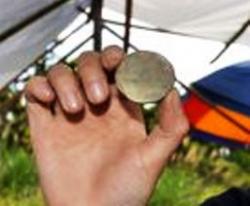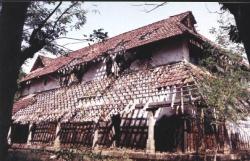10 FEVRIER
INSTITUT SUPERIEUR D’ANTHROPOLOGIE INDI-UNI :
INSCRIPTION 2012 / 2 COURS A DISTANCE
REGISTRATION 2012 /2 ONLINE COURSES
TAIWAN –  Puyuma - A team of National Taiwan University students dug up a rare jade core at the Puyuma Archaeological site in eastern Taiwan. The students also discovered a number of more common jade tubes. Around 6,000 items of jadeware have been unearthed from the site over the years, however, jade cores are considered to be very rare, said the museum's assistant researcher Lee Kun-hsiu. Used in jadeware production, a jade core is usually discarded after an item has been made, explained Lee. However, no jadeware factories have been discovered in the area, and the archaeological site is 100 kilometers away from the origin of the jade material, the researcher pointed out.
Puyuma - A team of National Taiwan University students dug up a rare jade core at the Puyuma Archaeological site in eastern Taiwan. The students also discovered a number of more common jade tubes. Around 6,000 items of jadeware have been unearthed from the site over the years, however, jade cores are considered to be very rare, said the museum's assistant researcher Lee Kun-hsiu. Used in jadeware production, a jade core is usually discarded after an item has been made, explained Lee. However, no jadeware factories have been discovered in the area, and the archaeological site is 100 kilometers away from the origin of the jade material, the researcher pointed out.
http://focustaiwan.tw/ShowNews/WebNews_Detail.aspx?Type=aEDU&ID=201202100039
ESPAGNE – Ibiza - Spotlight has featured many stories of archaeological finds and remnants of ancient civilisations which have been unearthed during building projects. Now, a new find has been made during the dredging process of Botafoch harbour. A 17th century ship was uncovered during the operations and already many relics – including two bronze canons – have been brought to the surface for study and eventual housing in a museum. The eventual aim is to raise the ship Mary Rose style from the sea bottom and preserve it for future generations. This is such a time consuming and expensive operation that it cannot be done now when it would delay such an important project. The island authorities have therefore decided to mothball the ship by completely covering it in a thick layer of sediment and then building the already planned car park on top of it. When the time is right in the future, it will be relatively easy to uncover the ship to raise and eventually display it to the public.
http://www.ibiza-spotlight.com/news/2012/underwater_archaeology_i.htm
INDE -  Eraniel palace - The Eraniel palace, about 20 km from Nagercoil, is regarded as a treasure house of the Venad history but its present state is a pale shadow of its glorious past. The palace, now under the control of Hindu Religious and Charitable Endowment Department of the State government, has traditional architectural characters from temple architecture of south India. Its notable features are low-tiled roofs, structures with central court yard (nadumuttam) and gable windows. According to sources in the Kerala government's Archaeology Department, Cheran Perumal, the most famous ruler of the Chera dynasty of the 8th century B.C., was said to have constructed the Eraniel palace and fort over an extent of around 3.5 acres of land. The palace lost its importance after the Venad dynasty shifted its capital to Padmanabhapuram on completion of the Padmanabhapuram Palace around 1601. Two hundred years later, when Veluthampi Dalawa (Thalavai) was the chieftain of the Travancore kingdom during 1802-1809, it gained prominence again. One of the streets in Eraniel is called ‘Padayetti Theru' as it was from there that Veluthampi led an army to take on the British. On re-organisation of States in 1956, the Kanyakumari district became part of Tamil Nadu and the Eraniel palace and its fort came under the control of Devasom Board. The palace was used as godown for some years and this hastened its dilapidation. At the entrance is the visitor's hall (yogamuri). It was where the then kings met select visitors. Beyond this is the inner hall (agathalam), guard's room, and kitchen. Next is the royal bedroom (vasantha mandapam) with a granite cot of five-foot width and six-foot length, made of a single stone. The palace was only an administrative office of the then kings but not the residential palace as their royal residence - Pamanabhapuram palace - was hardly five km from Eraniel. There was a ‘vaadavilakku', an ever burning light, in the vasantha mandapam. Besides the chambers in the palace, there is a small tank for the royal bath and a secret tunnel for emergency escape. There were 23 tamarind trees on the premises of the palace. Of them, tamarind from one tree was very sweet and it was said to be used for the Kings.
Eraniel palace - The Eraniel palace, about 20 km from Nagercoil, is regarded as a treasure house of the Venad history but its present state is a pale shadow of its glorious past. The palace, now under the control of Hindu Religious and Charitable Endowment Department of the State government, has traditional architectural characters from temple architecture of south India. Its notable features are low-tiled roofs, structures with central court yard (nadumuttam) and gable windows. According to sources in the Kerala government's Archaeology Department, Cheran Perumal, the most famous ruler of the Chera dynasty of the 8th century B.C., was said to have constructed the Eraniel palace and fort over an extent of around 3.5 acres of land. The palace lost its importance after the Venad dynasty shifted its capital to Padmanabhapuram on completion of the Padmanabhapuram Palace around 1601. Two hundred years later, when Veluthampi Dalawa (Thalavai) was the chieftain of the Travancore kingdom during 1802-1809, it gained prominence again. One of the streets in Eraniel is called ‘Padayetti Theru' as it was from there that Veluthampi led an army to take on the British. On re-organisation of States in 1956, the Kanyakumari district became part of Tamil Nadu and the Eraniel palace and its fort came under the control of Devasom Board. The palace was used as godown for some years and this hastened its dilapidation. At the entrance is the visitor's hall (yogamuri). It was where the then kings met select visitors. Beyond this is the inner hall (agathalam), guard's room, and kitchen. Next is the royal bedroom (vasantha mandapam) with a granite cot of five-foot width and six-foot length, made of a single stone. The palace was only an administrative office of the then kings but not the residential palace as their royal residence - Pamanabhapuram palace - was hardly five km from Eraniel. There was a ‘vaadavilakku', an ever burning light, in the vasantha mandapam. Besides the chambers in the palace, there is a small tank for the royal bath and a secret tunnel for emergency escape. There were 23 tamarind trees on the premises of the palace. Of them, tamarind from one tree was very sweet and it was said to be used for the Kings.
http://www.thehindu.com/news/states/tamil-nadu/article2876294.ece?homepage=true
INDE – Sunet - 26 years after it took possession of land which threw up ancient coins, utensils and artefacts, ASI seems uninterested in carrying out further excavation. Kesaro and Nirbhay are proud owners of archaeological finds and so is nearly every other resident of the village, which is surrounded by Bhai Randhir Singh Nagar, a posh colony Old timers talk about the pre-Independence era when people arrived with tools to dig up the mounds dotting the village. However, it was only in 1984 that the Archaeology Survey of India (ASI) decided to take up excavations here and hit the goldmine when its teams recovered thousands of coins and seals dating as old as first century AD. The same year, the ASI took possession of nearly 8.5 acre of land from Ludhiana Improvement Trust to carry out more research work. The ASI got a boundary wall built to mark the land, dotted with a number of ancient earthen mounds. However, 26 years on, the ASI is yet top commence work in the earmarked area even as the plot is slowly turning into a garbage dump.
http://www.indianexpress.com/news/sunet-sits-on-archaeological-goldmine-asi-slumbers-on/910176/0
FRANCE –  Lyon - Commencé en juillet 2011, le chantier de fouilles de l’Antiquaille, actuellement réalisé par le Service archéologique de la Ville de Lyon, se situe sur un belvédère remarquable à proximité immédiate des théâtres romains. Pendant cinq siècles d’occupation, la vocation du site change à maintes reprises : successivement couvent de l’ordre de la Visitation au XVIIe siècle, caserne pendant la Révolution française, puis asile, l’Antiquaille devient hospice puis hôpital en 1803. Qualifié de "laboratoire de la modernité", il contribuera pendant 200 ans au rayonnement de la médecine lyonnaise. Fermé en 2003 lors de la réorganisation des Hospices civils de Lyon, l’Antiquaille accueille des réalisations immobilières auxquelles ont été associées, depuis 2006, des opérations archéologiques.
Lyon - Commencé en juillet 2011, le chantier de fouilles de l’Antiquaille, actuellement réalisé par le Service archéologique de la Ville de Lyon, se situe sur un belvédère remarquable à proximité immédiate des théâtres romains. Pendant cinq siècles d’occupation, la vocation du site change à maintes reprises : successivement couvent de l’ordre de la Visitation au XVIIe siècle, caserne pendant la Révolution française, puis asile, l’Antiquaille devient hospice puis hôpital en 1803. Qualifié de "laboratoire de la modernité", il contribuera pendant 200 ans au rayonnement de la médecine lyonnaise. Fermé en 2003 lors de la réorganisation des Hospices civils de Lyon, l’Antiquaille accueille des réalisations immobilières auxquelles ont été associées, depuis 2006, des opérations archéologiques.
http://www.viafrance.com/evenements/les-sous-sols-de-l-antiquaille-exposition-769867.aspx
FRANCE – Alsting - Un site néolithique a été mis au jour à Alsting. Une découverte réalisée dans le cadre de fouilles archéologiques préventives, opérées en octobre par l’INRAP (Institut national de recherches archéologiques préventives) sur un chantier de lotissement. « C’est la première fois que l’on trouve une carrière d’extraction de chailles (matériaux silicieux) dans ce secteur. D’autres carrières sont connues mais dans la région de Saint-Mihiel et Commercy, s’enthousiasme Marie-Pierre Petitdidier, qui a supervisé cette fouille. Les chailles ont été utilisées en Lorraine pour fabriquer des outils depuis le paléolithique moyen (300 000 à 30 000 avant notre ère) voire le paléolithique ancien jusqu’à la fin du néolithique (aux environs de 2000 avant notre ère).Localement, cette période est mal connue et tout élément d’information supplémentaire a son importance. » Pour ce qui est de la datation du site, jugé « exceptionnel », l’archéologue donne une fourchette de 3500-3400 ans avant J.C. « Un fragment d’une noisette carbonisée trouvée pendant les sondages a été envoyé dans un laboratoire en Floride pour une datation au carbone 14. Lesétudes à venir devraient permettre de dater le début d’exploitation de cette carrière », précise la spécialiste, indiquant que la terre prélevée lors des fouilles sera bientôt tamisée à l’eau. « Nous verrons si nous y trouvons de petits outils en silex, pointes de flèche, grattoirs. » Cette découverte permettra d’appréhender ce que devaient être les échanges entre populations dans le bassin de la Sarre au néolithique, période où les chasseurs cueilleurs commencent à devenir des sédentaires, équipés d’outils qui évoluent. « Des questions se posent sur le travail dans cette carrière. Les blocs de chaille étaient-ils seulement taillés sur place ou produisait-on aussi des outils à Alsting, s’interroge l’archéologue. Nous n’avons pas retrouvé de traces d’habitat là où nous avons sondé, mais il est tout à fait possible qu’il en existe tout près. »
http://www.republicain-lorrain.fr/actualite/2012/02/10/decouverte-d-une-mine-du-neolithique